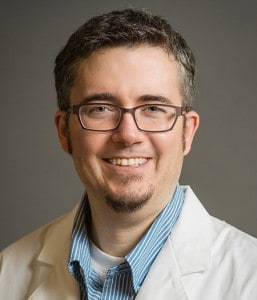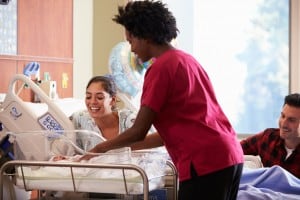October is Sudden Infant Death Syndrome Awareness Month, and Regional One Health is starting a new Safe to Sleep initiative to help parents prevent a tragedy.
Our doctors and nurses are educating parents about safe sleep spaces and positioning for their baby, and even modeling that behavior through hands-on demonstrations.
The project is part of a statewide effort focused on implementing best practices at hospitals all over Tennessee.
Picture a sleeping baby snuggled in a fluffy blanket, surrounded by pillows and teddy bears. Did you know that’s actually an unsafe sleep situation?
Regional One Health’s Safe to Sleep initiative is giving expectant and new parents evidence-based information about infant sleep safety. The project, which is part of the Tennessee Initiative for Perinatal Quality Care, uses education and demonstrations to help prevent a tragedy.
Neonatologist John Purvis, MD, FAAP, said it’s a message all parents should hear: “There’s a learning curve for almost everyone, even experienced parents. We should never assume parents already know.”
Lilly Cooper, MSN, RN, NE-BC, nursing director for women’s services, said data backs that up.
There are an estimated 3,500 sleep-related infant deaths in the United States each year, including over 140 in Tennessee. Unsafe sleep practices are common: 22 percent of parents don’t put their baby on their back, 39 percent use soft bedding, and 61 percent do at least some bed-sharing.

“Parents are receptive to this education, so we feel we can have a big impact,” said Dr. John Purvis. “If we can change behavior, we can help keep babies safe.”
Cooper said the TIPQC project aims to change those behaviors through education, modeling and reinforcement. “This is education for everyone – everyone can save a life. It’s a great initiative, and our staff is incredibly engaged and eager to take a leadership role.”
While some risk factors can’t be mitigated – sleep-related death is more common in premature infants, boys, African Americans and Native Indians, and babies with brainstem abnormalities –TIPQC focuses on what parents can control:
Babies should have their own sleep space, like a crib, pack-n-play or bassinet. Never co-sleep (a baby could be smothered by a parent, suffocate under blankets or pillows, or fall out of bed) but do keep your baby’s bed in your room for the first six months.
Don’t use fluffy toys and bedding. “Those are suffocation hazards,” Dr. Purvis said. “It doesn’t take much for the infant to jostle and cause a toy or pillow to fall over their face.”
Place your baby on their back: “On their side or belly, their nose and mouth can be obstructed,” he said. “Babies lack the motor control to lift up or roll over, so they can’t rescue themselves.”
When a baby sleeps facedown or something covers their face, they breathe into a smaller space and may rebreathe carbon dioxide. As their carbon dioxide level rises, respiration slows. Since babies already have an immature respiratory drive, their breathing could unintentionally turn off.
Dr. Purvis also dispelled the myth that a baby on their back is more likely to choke if they spit up.
He noted the epiglottis acts as a “trap door” to stop spit-up from getting in the airway when a baby is lying on their back, so it’s less likely they’ll choke. It’s actually more likely for spit-up to remain in the mouth and block the airway if a baby is on his or her stomach.
It’s all crucial advice for parents, and Dr. Purvis said Regional One Health has a great team in place to spread the word.

Doctors and nurses are providing education and also modeling the correct behaviors. Their goal is to help parents create safe sleep situations for their babies at home.
Jehan Ellis, RN, starts by educating expectant parents in her childbirth classes. “We talk about having a bassinet or crib for the baby to sleep in, and remind parents that even if the baby wakes through the night, they should put the baby back in their own bed,” she said.
Reaching parents before their baby is born gives them time to ask questions, address concerns and form a plan, Ellis said: “We give them accurate information right from the start. When they hear it again in the hospital, it really takes hold.”
Nurse manager Sharonda Taylor, RN, and professional development specialist Adrienne Walton, MSN, oversee education once babies are born.
Walton is training antepartum and mother/baby nurses on Safe to Sleep, and she’s impressed with their expertise and commitment: “The knowledge base of our nurses is exceptional. Now, our focus is having them model the appropriate behavior and give patients the rationale behind it.”
Taylor is spearheading safe sleep audits to see if the effort is changing behavior and to identify common missteps to better tailor the education.
As TIPQC project leads, Walton and Taylor share their data statewide, contributing to a pool of information that will help providers learn from one another and develop best practices.

Babies should have their own sleep space, but should be in the parents’ room for the first six months. Keep fluffy toys, pillows and blankets out of the baby’s bed.
Cooper is excited to see her team take the lead in improving care for patients across the state. As their efforts continue, she hopes to train more providers on how to best reach parents with Safe to Sleep education.
So far, it’s proving to be a welcome message coming from welcome messengers.
“Studies say nurses are the most trusted health care professionals, and we also spend more time with the patient,” Walton said. “We’re always at the bedside, and we want to make that time valuable. We know we’re not only caregivers, we’re teachers and confidantes.”
“Parents are receptive to this education, so we feel we can have a big impact,” Dr. Purvis added. “Research shows there’s a huge decrease in the risk of infant death from sleep position alone, so if we can change behavior, we can help keep babies safe.”